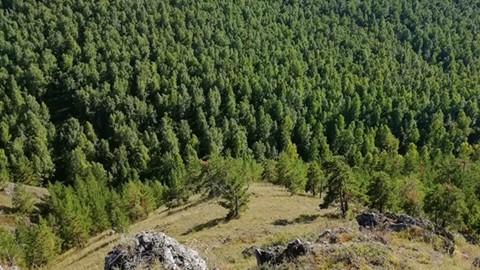Siberian Federal University Researchers Analyze ‘Climate Diaries’ in Scots Pine Cellular Structure
SibFU researchers have decoded information about short-term climate fluctuations in the cells of Scots pine trees growing in the southern part of Siberia, in the Khakassia Republic.
The research results were published in Journal of Forestry Research. It has been found that even minor differences in temperature and precipitation can significantly affect the timing of pine tree growth, as well as the likelihood of drought in pine forests in the South Siberian region. The method proposed by scientists helps to predict fire-hazardous periods, prevent insect infestation, and calculate areas of forest that can be used to produce seeds for reforestation.
Every year, trees grow a new layer of wood, which is known as the annual ring. According to biological classification, wood is a type of xylem, which is a tissue that transports water from the roots to the leaves or conifers. In coniferous trees and shrubs, it consists almost entirely of tracheids — cells shaped like vertical tubes.
During the spring and summer season, xylem cells appear in turn by dividing the cells of the cambium located between the wood and the bark. Further, these cells increase in diameter, then their wall thickens, and finally, the tracheids lose their internal contents and become ready-made elements of the “internal plumbing” of the tree. Each cell has its own specific time frame for the stages of development. Therefore, we can assume that the weather conditions (temperature, precipitation, etc.) are “recorded” in these cells in great detail, along with their characteristics. The question is how to decode these detailed “diary entries” by measuring the size of cells and the thickness of their walls.
“The task is complicated since the size of wood cells has strict genetically determined restrictions so that the cells can successfully perform their functions. In addition, the conditions at the time when a cell begins its development will influence its entire future growth. As a result, we obtain nonlinear but clearly distinguishable dependencies between various characteristics of tracheids. We used long-term cellular measurements that are more than 200 years old. Very few of our colleagues around the world have access to such data. As a result, a team of scientists from SibFU proposed and successfully tested a method that allows them to mathematically calculate and separate the limitations and the impact of the “legacy of the past”, while mainly focusing on the records of current climatic conditions“, said Liliana Belokopytova, senior researcher at the Laboratory of Dendroecology and Environmental Monitoring of the Khakass Technical School, a branch of Siberian Federal University and the SibFU’s Laboratory of Biogeochemistry of Ecosystems. .
According to the scientist, this work continues a series of studies on the anatomy of the common pine wood in Southern Siberia. A comparison of pine trees in the forest-steppe regions of Khakassia and South Buryatia has shown that, even under similar formation conditions, the “records in the cells” differ in their writing time and content. However, these two regions are located more than 1,000 kilometers apart, so the difference in climate may be the reason for the discrepancy. However, in the new study, the experts analyzed the records from pine forests at a distance of only 120 kilometers from the first study site, near the village of Bograd and the vicinity of Kazanovka, Khakassia. It would seem that the distance is short, and the pine trees were picked from the foothills of the ridges surrounding the same valley. However, despite their close geographical proximity, even small differences in temperature and precipitation have a significant impact on the timing of wood formation and the likelihood of pine trees in the Khakassia forest-steppe experiencing drought.
“It can be argued that the proposed method for separating climate records functions stably and reliably, providing details of weather conditions that are important for tree growth. For forest protection organizations in the region, it can be useful to calculate the times when pine forests are at the highest risk of fire due to drought. It can also be helpful to determine which trees and areas are more vulnerable to pests and which ones adapt better to a changing climate, therefore, can be used as a source of seeds for reforestation”, resumed Dina Zhirnova, senior researcher at the Laboratory of Dendroecology and Environmental Monitoring of the Khakass Technical School and the SibFU’s Laboratory of Biogeochemistry of Ecosystems.

